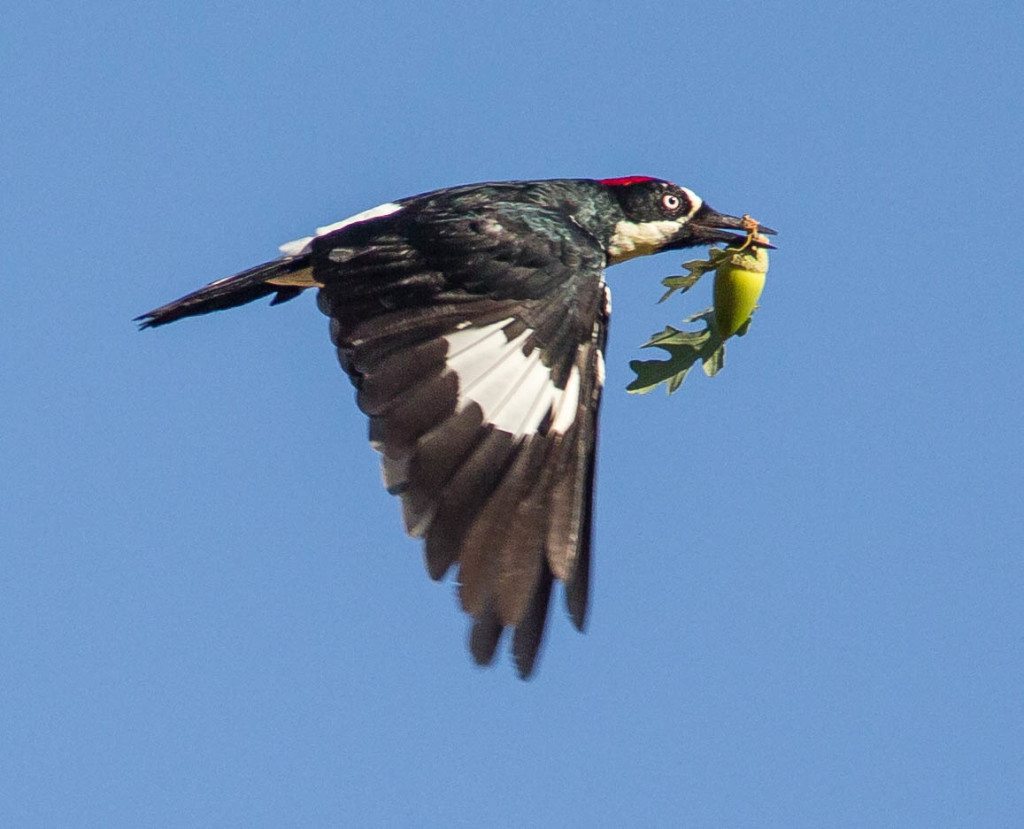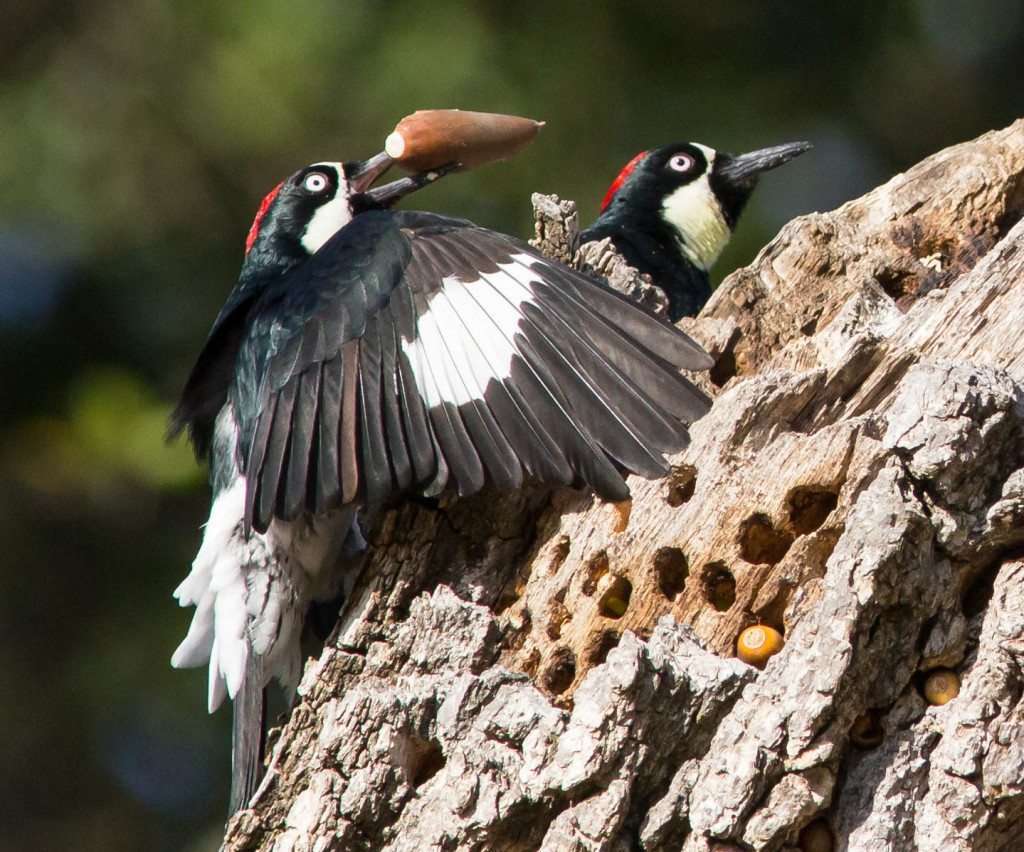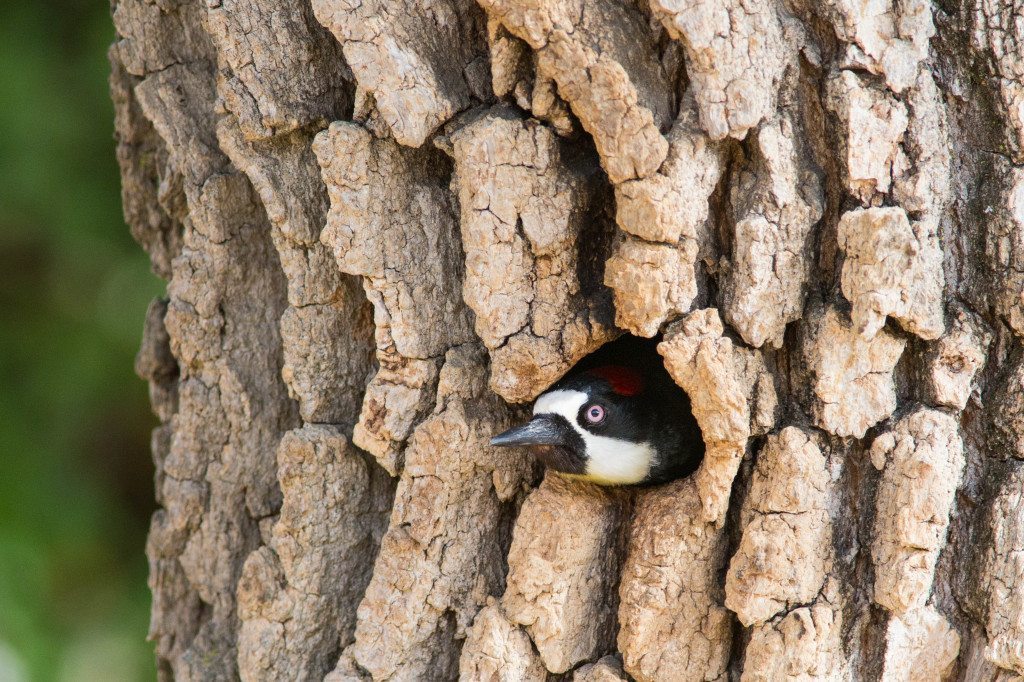Why so many Acorn Woodpeckers?
By Bruce Mast
They are the clowns of the oak savannah — Acorn Woodpeckers — with their harlequin faces, gregarious habits, and off-kilter laughing calls that inspired Woody Woodpecker. According to Birds of North America, the “Acorn Woodpecker is a common, conspicuous inhabitant of foothill and montane woodlands from northwestern Oregon, California, the American Southwest, and western Mexico through the highlands of Central America to the northern Andes in Colombia. Throughout its range, this species is closely associated with oaks (genus Quercus) and is most commonly found in pine-oak woodlands.”
Here in the Bay Area, Acorn Woodpecker colonies are fairly common in the East Bay hills and the western slopes of Mount Diablo, particularly where there are concentrations of valley oaks. South of Livermore, they can be locally abundant in the Diablo range. They are rare in Tilden and Redwood Regional Parks and practically unheard of west of the Hayward Fault.
So what’s up with the recent spate of Acorn Woodpecker sightings in urban San Francisco and the East Bay lowlands?


Beginning around September 1st, Acorn Woodpecker reports started rolling in from multiple East Bay sites from Oakland to Richmond. The irruption hit San Francisco by September 12 when twelve birds were noted flying over Battery Godfrey. S.F. birders started finding bands of Acorns in Buena Vista Park, Lincoln Park, and Golden Gate Park, and solo flyover birds were all over town.
This irruption is particularly noteworthy because Acorn Woodpeckers are not migratory. What’s driving it? The most likely answer is acorn crop failure.
True to their name, Acorn Woodpeckers are acorn specialists. They develop communal granaries that may consist of tens of thousands of holes drilled in tree trunks and limbs, each stuffed with an acorn. Only about half their diet actually consists of acorns — the other half is made up of fruit, insects, and other vegetable matte r— but the acorn granaries are the staple food source that gets them through lean times. Again quoting BN:
[i]n areas where there are large seasonal fluctuations in insects and other foods, year-round residency is dependent on the birds’ ability to store sufficient acorn mast to provide food throughout the winter. Groups that exhaust their stores often abandon their territories and wander off in search of alternative food.
This year appears to be one of those years. According to the October 2014 edition of the California Acorn Report, this is a medium-to-poor acorn year. Results are particularly poor for live oaks: it is either the worst or next-to-worst year ever for coast live oaks, canyon live oaks, and interior live oaks. Blue oaks are generally fair to poor and it’s a fairly poor year for tanoaks. The valley oak crop is reasonably good but, overall, acorn production is the worst it has been since 2003 and less than half the crop production of 2012 and 2013.


So what does the future hold for our clown-faced friends? Is crop failure due to drought or just cyclical variation in acorn mast production? University of California’s Oak Woodland Conservation Workgroup sheds some light on the drivers of crop size:
For valley and blue oaks, the most important single factor is weather in April, the peak month for pollination, with crops being heavier in years when mean April temperatures are warmer. … For coast and canyon live oaks, mean acorn production is positively correlated with rainfall occurring one and (for canyon live oak) two years earlier. … Interestingly, winter rainfall in the same year as acorn production-the factor most commonly thought to determine crop size-does not correlate positively with mean annual crop size of any of the species we studied.
So it’s quite possible this year’s poor crop is attributable to the rain we didn’t get a couple years ago. In that case, it may be a while before acorn crops return to their 2012-2013 levels. In the meantime, here’s hoping our feathered friends find some good food sources in their new urban digs.
————————————-
Bruce Mast writes Golden Gate Bird Alliance’s monthly Observations column on rare and unusual bird sightings, which you can read on our web site. To submit a sighting, email him at observe@goldengatebirdalliance.org. Bruce has devoted his professional career to promoting green building practices to reduce the climate impacts from our homes. In his spare time, he has often enjoyed the company of Acorn Woodpeckers on long hikes through the hinterlands of the East Bay hills, Mount Diablo, and the Ohlone Wilderness.
